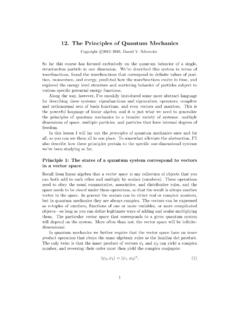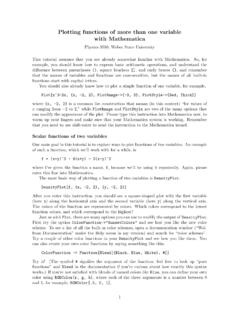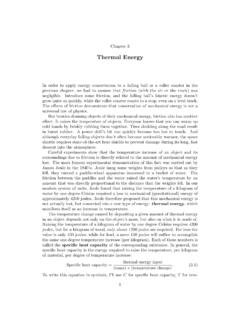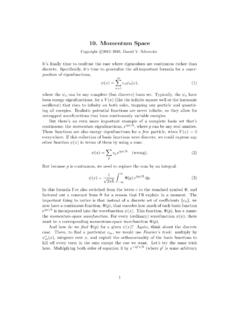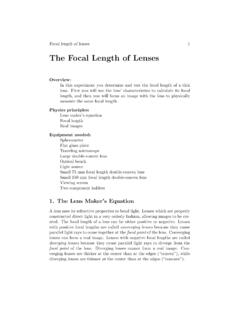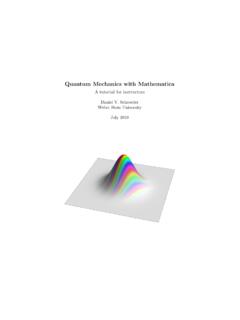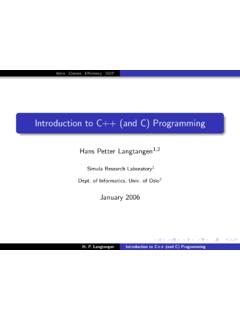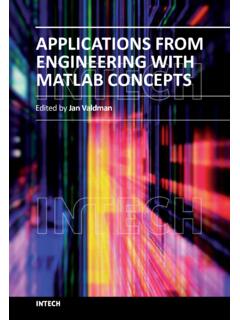Transcription of Physics Simulations in Python
1 Physics Simulations in PythonA Lab ManualDaniel V. SchroederPhysics DepartmentWeber State UniversityAugust 2021 Copyrightc 2018 2021, Daniel V. fromPhysics Simulations in Java, copyrightc 2005 work is licensed under the Creative Commons Attribution Interna-tional License. To view a copy of this license, send a letter to Creative Commons, PO Box 1866,Mountain View, CA 94042, can obtain the latest version of this manual There you can also find the LATEX source and il-lustration files, to facilitate adapting this manual to different .. ivProject 1: Making Shapes .. 1 Project 2: Projectile Motion .. 11 Project 3: Pendulum .. 25 Project 4: Orbits .. 35 Project 5: Molecular Dynamics .. 47 Project 6: Random Processes .. 61 Project 7: Final Project .. 73iiiPrefaceIntroductory Physics courses are full of simplifications: projectiles fly without airresistance, pendulums swing only at small angles, orbits are always circular, andno more than two particles move at any time.
2 These kinds of simplifications arenecessary and appropriate when you re first trying to understand the basic laws ofnature. But the real world is far more complex, and far more interesting. Becausethe ultimate goal of Physics is to understand the real world, students deserve acourse that applies the laws of Physics to more complex , modern electronic computers make it possible to perform extremelylengthy calculations in a negligible amount of time. These days, therefore, com-puters offer the best avenue toward applying the basic laws of nature to complexand realistic physical systems. A computer program that models the behavior ofa physical system is called acomputer simulation. Creating and using computersimulations is an integral part of modern science and manual is intended for a hands-on introductory course in computer simu-lations of physical systems, using the Python programming language.
3 The goals ofthe course are as follows: Learn enough of the Python language and the VPython and matplotlib graph-ics packages to write programs that do numerical calculations with graphicaloutput; Learn some step-by-step procedures for doing mathematical calculations (suchas solving differential equations) on a computer; Gain a better understanding of Newton s laws and other physical principles; Study a variety of physical systems that are too complex for simple pencil-and-paper calculations, and see what sorts of behavior emerge in such working through the projects in this manual you should have completed asemester of introductory Physics , covering Newton s laws of motion, conservationprinciples, and a bit of thermodynamics. You should also have taken at least onesemester of calculus. Prior expertise in writing computer programs isnotrequired,but you should be fairly comfortable using a web browser, word processor, andspreadsheet, and you should have some experience at being careful with computersyntax (in any programming language).
4 IvPrefacevRequired materialsNaturally, you ll need a computer. The first five projects use a cloud-based versionof Python called GlowScript, so for those you can use any computer with an internetconnection and a modern web browser. (A tablet device without a physical keyboardis not adequate.) For Project 6, you may need to install a free version of the Pythonlanguage and environment (if you re not using a computer on which it is installedalready).Your GlowScript programs will be automatically saved on Google s servers, butfor any other files you ll need to use either some other type of cloud storage or aUSB memory stick for pocket calculator (perhaps on your mobile phone) will sometimes come , you ll need a few low-tech materials such as scratch paper, pencils, aruler, and a small three-ring binder to hold this to use this manualThis manual is divided into six main chapters, corresponding to six separate each project you will write a computer program or (more often) a small numberof closely related computer programs.
5 Rather than giving you complete programs torun, the project instructions will provide only code fragments and general guidelineson how to write your programs. This way, once you have completed each program,it will be you create your computer programs, you will inevitably have questions andencounter difficulties. While you should try to think things through for yourselfwhenever possible, don t spend too much time being stuck and getting your instructor or your lab partner or your other classmates for help. This isnot a and questions will be sprinkled among the instructions in this manual,with space for you to write your answers. Please make every effort to work eachexercise and answer each question immediately, before you read general premise of this manual is that you ll learn more bytryingsome-thing than by reading a comprehensiveexplanationof it. Computer languages arelike ordinary languages in this respect: We normally learn new words by hearing,reading, and using them in context, not by studying a dictionary.
6 But if you wantto see a term clearly defined, feel free to ask your instructor or look it up programming is fun because it s so open-ended. You ll constantlythink of things to try that go beyond the explicit instructions. By all means, tryanything you want! If you re not sure how to add a certain feature to one of yoursimulations, or if you re not sure whether it s practical to do so within a limitedamount of time, be sure to ask your you finish a project, gather the instruction pages and staple them togetherwith any printed output from your programs. This stapled packet, together withviPrefacethe source code of your computer programs, will be your lab report. What this manual is notThis manual is not a comprehensive introduction to the Python programming lan-guage. Many features of the language are not needed for the types of simulationswe ll be doing, so we ll ignore them.
7 Several other features will be used once ortwice but never fully distributions of Python come with dozens of packages (libraries) forcarrying out a wide variety of common tasks. This manual will describe only a tinyfraction of some point you might want to distribute your finished Python programs asweb apps or stand-alone applications. This manual won t tell you how to do ve tried to design the examples in this manual to illustrate good programmingpractices that are appropriate to the relatively small scale of the projects. This isnot a treatise on the principles of professional software manual is not a textbook on numerical analysis, nor is it a reference workon numerical algorithms. We ll try out just a few algorithms, make some crudecomparisons, and leave it at projects in this manual touch on some fascinating fields of Physics , includingnonlinear dynamics, celestial mechanics, and phase transformations.
8 But this is nota textbook on any of these most importantly, this manual is not intended to be of any use what-soever to someone who merely reads it without actually working through all of theprojects and Python , VPython, and GlowScript?Choosing a computer programming language always involves trade-offs. Fortu-nately, there are more choices today than ever obvious choice for this course would be one of the traditional computerlanguages like fortran , C, or C++. These languages are widely used for scien-tific computation due to their flexibility and speed. The languages are defined bystandards committees rather than by commercial vendors, and free versions areavailable. However, they have grown somewhat complex over the years, as featureshave been added while maintaining compatibility with older versions. Another dis-advantage is that none of these languages include built-in support for graphics, andadd-on graphics libraries tend to be difficult to install and Basic programming language was specifically designed to be easy to learn,and current versions of Basic have kept this feature.
9 Because Basic is widely usedby students and hobbyists, all modern versions include built-in, easy-to-use graph-ics support. Some versions are cross-platform, but the most widely used version,Microsoft s Visual Basic, runs only on the Windows operating system. The fragmen-tation of Basic into multiple versions, each with its own idiosyncracies, is a majorPrefaceviidisadvantage. Programs written in Basic also tend to run rather slowly. Mostversions of Basic are sold commercially, though the prices are generally mathematical calculations, the most convenient choice is often a specializedmathematical programming environment such as Mathematica (which I use a greatdeal), Maple, or Matlab. These packages contain sophisticated, speedy, built-inroutines for a great variety of mathematical tasks, but their high overhead canmake them rather slow and awkward when you need to program a custom step-by-step algorithm.
10 Because they are commercial products aimed at relatively narrowmarkets, these packages tend to be expensive. (However, there is a free productcalled Octave that is very similar to Matlab.)An earlier version of this manual used the Java programming language, intro-duced by Sun Microsystems (now Oracle) in 1995. Although based on C and C++,Java is easier to learn and use, and comes with standard cross-platform libraries forgraphics and other common tasks. Its computational performance is remarkablygood, though it isn t as fast as C or C++ or fortran . But Java never really caughton with scientists, and its early use for web-delivered applets has now become ob-solete. More importantly for us, programming in Java requires some inconvenientsoftware installations and learning to use some rather advanced object-oriented fea-tures that are really superfluous in a first course in scientific web-delivered applications, Java has now been replaced by JavaScript, arather different language that was deliberately named to emphasize their superficialsimilarities.
